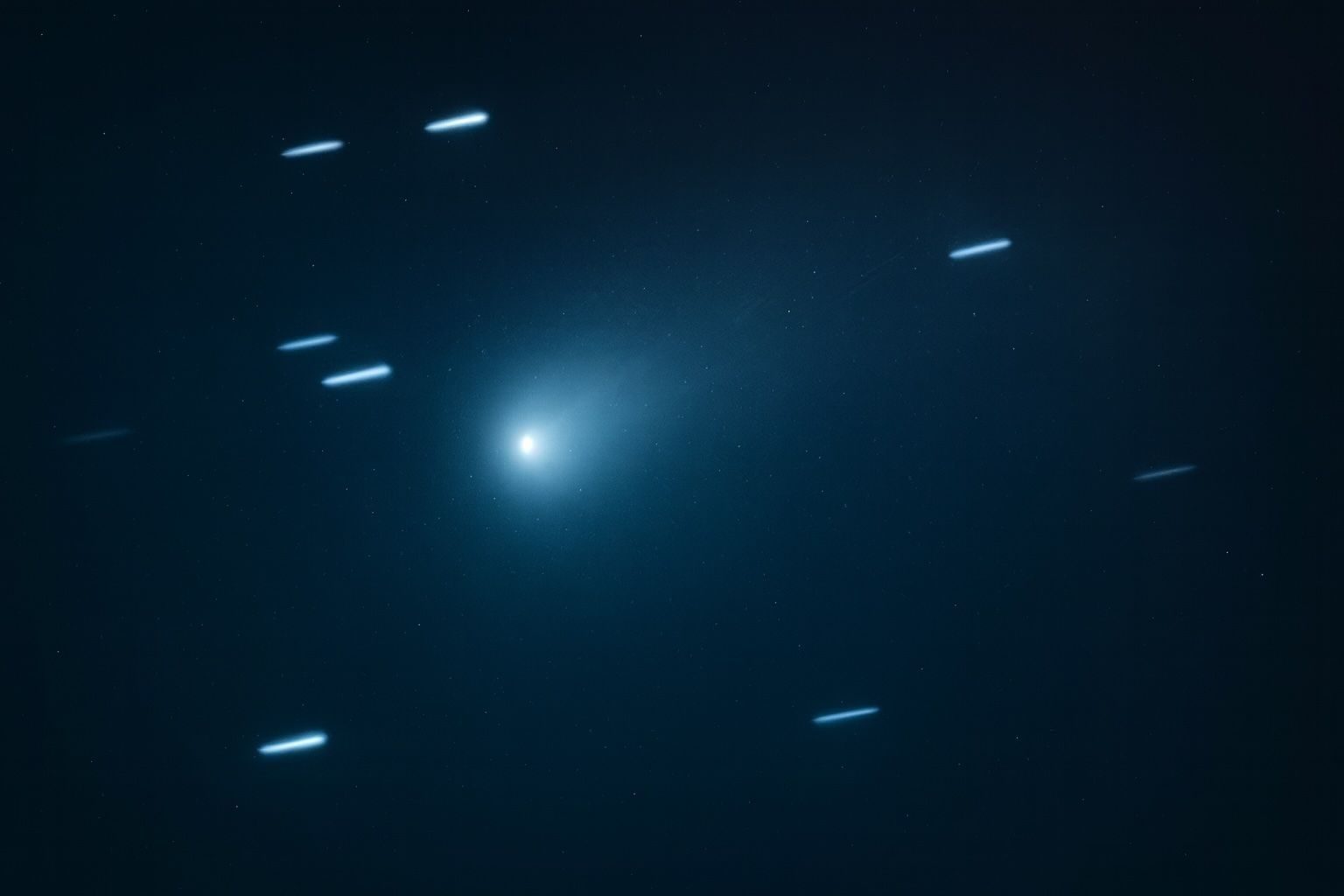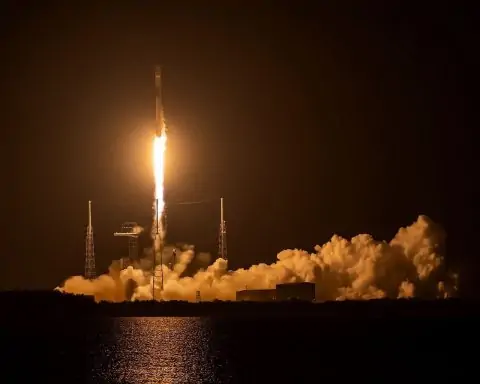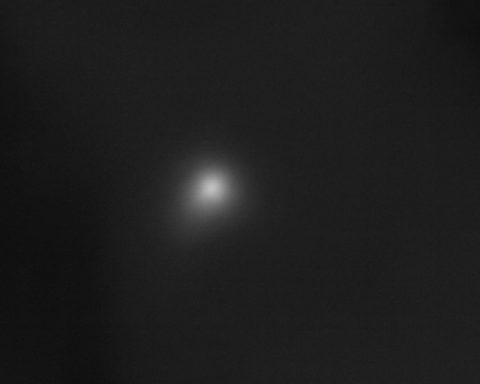On November 27, 2025, interstellar comet 3I/ATLAS is doing far more than quietly gliding through the pre‑dawn sky. It has just become the official focus of a United Nations planetary‑defense exercise, its orbit has been sharply refined using data from spacecraft around Mars, and it continues to fuel viral claims that it might be an alien probe — claims mainstream scientists strongly reject. [1]
Below is a full breakdown of what’s actually happening with 3I/ATLAS today and why it matters for science, planetary defense, and skywatchers.
Key developments on November 27, 2025
Several major 3I/ATLAS stories are breaking or being updated today:
- UN planetary‑defense exercise begins
The International Asteroid Warning Network (IAWN), working under a UN framework, has officially kicked off a global observing and astrometry campaign using 3I/ATLAS as a live training target. The exercise runs from 27 November 2025 to 27 January 2026, with a follow‑up teleconference scheduled for 3 February 2026. [2] - Confirmed: no threat to Earth
UN documentation and space‑agency statements stress that 3I/ATLAS poses no impact risk. Its closest approach to Earth will be about 1.8 astronomical units (≈270 million km / 170 million miles) on 19 December 2025 — nearly twice Earth’s distance from the Sun. [3] - Orbit sharpened using data from Mars orbiters
ESA scientists, reporting via a new analysis highlighted today, show that combining images from the ExoMars Trace Gas Orbiter and Mars Express with Earth‑based observations improved the accuracy of 3I/ATLAS’s trajectory by about a factor of ten. [4] - Fresh wave of “alien probe” speculation
New commentary and follow‑up reporting build on Harvard astrophysicist Avi Loeb’s suggestion that 3I/ATLAS’s small non‑gravitational acceleration and its future flyby near Jupiter might be consistent with a technological craft dispatching probes — an idea that remains very much a minority view. NASA and ESA continue to state that all data are fully consistent with a natural, if unusually active, comet. [5]
What is interstellar comet 3I/ATLAS?
3I/ATLAS (also cataloged as C/2025 N1 (ATLAS)) is only the third confirmed interstellar object ever seen passing through our Solar System, after 1I/ʻOumuamua (2017) and 2I/Borisov (2019). [6]
Key facts from NASA and other agencies: [7]
- Discovery:
Detected on 1 July 2025 by the Asteroid Terrestrial‑impact Last Alert System (ATLAS) telescope in Río Hurtado, Chile, with pre‑discovery images later traced back to May–June 2025. - Why “3I”?
The “I” stands for interstellar; the “3” marks it as the third such object discovered. - Orbit:
3I/ATLAS follows a strongly hyperbolic path, meaning it’s not gravitationally bound to the Sun and will never return once it departs. - Perihelion:
It made its closest approach to the Sun on 29–30 October 2025, roughly between the orbits of Earth and Mars. [8] - Size:
Observations from Hubble and other major telescopes suggest a nucleus somewhere around 0.3–5.6 km across, with many analyses favoring a size under 1 km. TS2 Tech+1 - Composition:
Spectroscopic data indicate 3I/ATLAS is unusually rich in carbon dioxide (CO₂) and relatively poor in watercompared with typical Solar System comets, suggesting it may have formed in an extremely cold region of another star system. TS2 Tech+1
In short, 3I/ATLAS is a small, fast, CO₂‑rich comet from another star system, briefly cutting through our neighborhood before heading back into deep space.
UN and IAWN: a live planetary‑defense drill, not an emergency
Today’s biggest 3I/ATLAS headline is political as much as scientific:
3I/ATLAS as the UN’s practice target
The United Nations Office for Outer Space Affairs (UNOOSA) and the International Asteroid Warning Network (IAWN) have designated 3I/ATLAS as the centerpiece of the eighth official global observing exercise since 2017. [9]
According to reporting from News.az and The Times of India, which draw on UN and IAWN documents, the campaign: [10]
- Runs from 27 November 2025 to 27 January 2026.
- Invites observatories and experienced amateurs worldwide to carry out highly precise position measurements (astrometry) of 3I/ATLAS.
- Is formally recognized as an IAWN observing exercise, coordinated with the Space Mission Planning Advisory Group (SMPAG) and UNOOSA.
- Explicitly states that 3I/ATLAS is harmless; the goal is training and benchmarking, not emergency response.
A published campaign timeline includes registration deadlines, a pre‑campaign workshop, a mid‑campaign check‑in on 9 December 2025, and a close‑out teleconference on 3 February 2026. [11]
Why pick 3I/ATLAS?
IAWN and UN‑linked explainers highlight several reasons 3I/ATLAS is almost a “perfect” practice target: [12]
- It’s interstellar, so its orbit and behavior are inherently unusual and scientifically interesting.
- It’s faint but trackable for weeks, a realistic challenge for global coordination.
- Its hyperbolic, high‑speed path resembles what a truly hazardous interstellar object might look like in the future.
- As a comet (not a simple point‑like asteroid), its fuzzy coma and tail make astrometric measurements more complex — a useful test of techniques needed if a comet ever posed a genuine threat.
The exercise is essentially a dress rehearsal for a worst‑case scenario, conducted with a real object that happens to be safely distant.
Mars gives scientists a new angle on 3I/ATLAS’s orbit
While the UN drill is about how we watch 3I/ATLAS, a separate story today focuses on how well we now know where it’s going.
ExoMars and Mars Express tighten the trajectory
A new report from Universe Today details how ESA’s ExoMars Trace Gas Orbiter (TGO) and Mars Express were turned toward 3I/ATLAS as it passed Mars at a distance of roughly 29 million km in early October. [13]
By triangulating those Mars‑based views with Earth‑based telescope data, ESA’s Near‑Earth Object Coordination Centre was able to: [14]
- Cut the uncertainty in the comet’s trajectory by about an order of magnitude.
- Firmly confirm that it will pass Earth safely at about 270 million km on 19 December 2025.
- Provide more precise predictions for its March 16, 2026 flyby near Jupiter, when it will pass tens of millions of kilometers from the giant planet — scientifically interesting, but nowhere near a collision course. [15]
ESA notes that its JUICE mission, currently en route to the Jovian system, is also observing 3I/ATLAS, though those data won’t arrive until 2026. [16]
This is the first time trajectory refinement for such an object has relied so heavily on a spacecraft orbiting another planet, an approach that planetary‑defense planners see as a powerful template for future emergencies. [17]
Weird tail, strange jets – and what’s really anomalous
3I/ATLAS has already built a reputation as a slightly odd comet, and recent coverage has amplified that image.
Tail or no tail?
- Earlier in November, some outlets reported that 3I/ATLAS appeared to have no obvious dust tail, despite being active, fueling speculation that it might not be a normal comet at all. [18]
- More recent imagery, including reports via Space.com, shows a growing ion tail and complex structures, including possible “anti‑tail” features that seem to point toward the Sun under certain viewing geometries. [19]
To comet researchers, this is weird but not supernatural. The mix of CO₂‑driven jets, unusual dust grains, and viewing geometry can make tails appear faint, lopsided, or even sunward from Earth’s point of view. TS2 Tech+1
Non‑gravitational “push”
High‑precision orbit fitting around the late‑October perihelion shows a small non‑gravitational acceleration, a tiny “extra push” beyond what gravity alone would produce. For comets, this is normal: gas and dust jets act like minuscule thrusters, and standard JPL software includes such terms as a matter of routine. TS2 Tech+2IFLScience+2
What’s new is only how well we can now measure that effect for an interstellar comet, thanks to the dense, multi‑mission data set.
The “alien probe” narrative, and the scientific reality
Despite agency reassurances, some commentators have seized on 3I/ATLAS’s quirks to spin more sensational ideas.
What the speculation says
Harvard astrophysicist Avi Loeb and a handful of others argue that: [20]
- The observed non‑gravitational acceleration might be too large for standard outgassing models unless the comet is losing an implausibly high fraction of its mass.
- The predicted Jupiter flyby around 16 March 2026 happens near the edge of Jupiter’s gravitational “sphere of influence”, which they see as suspiciously convenient for dropping off probes or satellites.
- 3I/ATLAS could, in an extreme scenario, be a “mothership” deploying smaller objects to study the outer planets.
These ideas have surfaced in op‑eds, interviews, and tabloid‑style headlines — and they are certainly attention‑grabbing. [21]
What mainstream science says
NASA, ESA, and most comet specialists remain firmly grounded: [22]
- All available data — the hyperbolic orbit, the dust and gas spectrum, images from Hubble, JWST, Mars orbiters, and heliophysics spacecraft — are consistent with a small, icy comet.
- CO₂‑rich jets can be highly efficient, explaining the small trajectory tweak without invoking exotic physics.
- The Jupiter encounter distance is large on planetary scales; it’s ideal for studying how a fast interstellar object’s path is nudged by a giant planet, not for dropping anything into orbit. [23]
In other words, 3I/ATLAS is genuinely strange in ways scientists love, but there is still no evidence that it is anything other than a natural comet from another star system.
How and when to see 3I/ATLAS in the sky
If you want to experience the interstellar visitor for yourself, 27 November 2025 is the start of a good observing window, especially for dedicated amateurs.
Current ephemerides and observing guides indicate that: TS2 Tech+2Universe Today+2
- 3I/ATLAS is back in the pre‑dawn sky, roughly around the constellation Virgo, creeping northward over the coming weeks.
- Its brightness is around magnitude 9–10, far too faint for the naked eye but visible with a medium‑sized amateur telescope (≈8 inches / 200 mm or larger) under dark skies.
- You’ll need a clear eastern horizon and to start observing 90–120 minutes before local sunrise.
- Astronomy apps and online ephemeris sites now list 3I/ATLAS by name or by its designation C/2025 N1 (ATLAS), making it straightforward to pull precise coordinates.
The object will be best placed for coordinated professional observations around its closest approach to Earth on 19 December 2025, though even then it will remain a faint smudge, not a dramatic naked‑eye showpiece. [24]
Don’t confuse it with the “other ATLAS” comet
Adding to the public confusion, another comet with “ATLAS” in its name has been making headlines this month.
- C/2025 K1 (ATLAS) — sometimes nicknamed the “other ATLAS” — is a completely different comet, discovered earlier in 2025.
- After a close pass by the Sun on 8 October 2025, it dramatically broke into multiple fragments, with astrophotographers capturing a spectacular disintegration sequence by mid‑November. [25]
- Its unusual golden glow and depleted carbon‑bearing molecules make it an intriguing object in its own right, but it is not interstellar and not the same as 3I/ATLAS. [26]
So: 3I/ATLAS = interstellar comet C/2025 N1, currently in a UN planetary‑defense drill; C/2025 K1 (ATLAS) = a Solar System comet that has just torn itself apart. The shared “ATLAS” tag simply reflects the discovery survey that found them.
Why today’s 3I/ATLAS news matters
Stepping back from the hype, the November 27 developments around 3I/ATLAS highlight three big themes:
- Planetary defense is becoming truly global
The UN‑backed IAWN exercise shows that the world is moving beyond theory to live, structured rehearsals with real celestial targets. The fact that this drill piggybacks on an interstellar comet underscores how seriously agencies now take the need for early warning and coordinated response. [27] - We’re getting better at tracking fast visitors
Using a Mars‑orbiting spacecraft to refine the path of an interstellar comet is a milestone. It demonstrates that, in a future crisis, data from across the Solar System could be fused quickly to determine whether an object is dangerous — and how to respond. [28] - Interstellar comets are laboratories for other star systems
With its CO₂‑rich, water‑poor composition and unusual dust properties, 3I/ATLAS gives astronomers a rare sample of material from a long‑dead planetary system somewhere in the Milky Way. Studying it may tell us how common our own Solar System really is — and how life‑friendly other systems might be. Sky & Telescope+3TS2 Tech+3NASA Science+3
Quick FAQ: 3I/ATLAS on November 27, 2025
Is 3I/ATLAS dangerous to Earth?
No. All major agencies agree it will stay about 1.8 AU away at closest approach — far outside any realistic impact zone. [29]
Why is the UN running a planetary‑defense drill if there’s no threat?
Because practice matters. 3I/ATLAS offers a rare, fast‑moving, interstellar target for a full‑scale test of detection, tracking and coordination — without any risk to the planet. [30]
Is there any solid evidence it’s an alien spacecraft?
No. A few researchers have floated highly speculative scenarios, but all observed properties can be explained by a natural, active comet. No agency has reported data that require a technological explanation. [31]
Can I see it tonight?
Possibly, if the weather cooperates and you have a reasonably large telescope, dark skies, and accurate coordinates from a sky app. Expect a faint, fuzzy patch in the pre‑dawn east — not a bright, dramatic comet. TS2 Tech+2NASA Science+2
References
1. www.universetoday.com, 2. news.az, 3. www.universetoday.com, 4. www.universetoday.com, 5. nypost.com, 6. science.nasa.gov, 7. science.nasa.gov, 8. time.com, 9. news.az, 10. news.az, 11. timesofindia.indiatimes.com, 12. news.az, 13. www.universetoday.com, 14. www.universetoday.com, 15. www.universetoday.com, 16. www.universetoday.com, 17. www.universetoday.com, 18. m.economictimes.com, 19. www.space.com, 20. nypost.com, 21. nypost.com, 22. time.com, 23. www.universetoday.com, 24. time.com, 25. www.livescience.com, 26. www.livescience.com, 27. news.az, 28. www.universetoday.com, 29. science.nasa.gov, 30. news.az, 31. time.com










